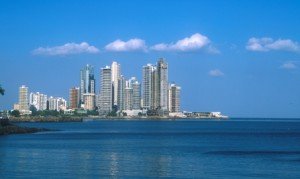 (International Living) Panama’s economy grew some 7% in 2010, fulfilling predictions that Panama would be one of the countries in the region least affected by the global financial crisis
(International Living) Panama’s economy grew some 7% in 2010, fulfilling predictions that Panama would be one of the countries in the region least affected by the global financial crisis
According to the Panama Bank Superintendancy, this country is well on its way to becoming the region’s chief financial hub.
Panama has just been chosen as the site of the Central American Council of Superintendents of Banks’ permanent headquarters. The agency’s objectives are to maintain and promote close cooperation between the banking superintendents of its member countries. The members currently include Costa Rica, Nicaragua, Honduras, Guatemala, El Salvador, Dominican Republic, and Panama.
Panama Bank Superintendant Alberto Diamond says the country’s financial hub grew an estimated 11.4% percent in 2010, with consolidated assets totaling $71.3 billion. Net revenue for the year totaled $1.67 billion, 16.1% or $148 million more than in 2009. Revenue came from dividends, foreign exchange transactions and commissions.
Domestic credits to the private sector totaled $24.3 billion, representing an increase of 13.3% over 2009. The increases were attributed to growth in the following sectors: industry (31.9%), commerce (22.7%), construction (12.7%), mortgages ( 9.8%) and individual consumption (8.7%).
Panama’s economy grew some 7% in 2010, fulfilling predictions that Panama would be one of the countries in the region least affected by the global financial crisis.
Despite the crisis that rocked the financial world in 2009, says Diamond, Panama’s banking center has continued to trend upward over the last four years. Growth has been largely due to stringent adherence to conservative banking standards, says the superintendent. For example, in 2010 Panama banks achieved just over 65.7% asset liquidity—well over the required 30%.
For more than three decades, Panama’s International Banking Center has been thriving. Banking alone accounts for about 11% of Panama’s Gross National Product (GNP). Powerful incentives like Panama’s rock-solid trusts make banking here very attractive.
Panamanian laws protect anyone who banks here and foreigners are guaranteed the same rights as local investors…great news for the hoards of expats that have recently moved here.
Panama has no central bank or monetary authority. Banco Nacional de Panama (BNP Panama National Bank) most closely resembles a national central bank serving as a repository for public-sector funds and as the government’s official banker and treasurer. The economy is fully dollarized, thanks to a treaty signed between Panama and the U.S. in 1904; just months after Panama declared independence from Colombia.
As BNP does not issue paper currency, it is instead responsible for managing the supply of dollars through an agreement with the Federal Reserve Bank of New York. Interestingly, Panama mints coins exactly the same shape and size as their U.S. counterparts; both U.S. and Panamanian coins are used here. (Watch out when you go to the U.S. or Canada, as you’ll invariably try to use a Panamanian coin by mistake.)
Panama’s banking superintendency is hard at work trying to attract Latin America’s big banks into setting up shop here, inviting Brazil, Mexico, Chile and others to help swell its numbers even further.
The IBC hosts some 80 banking institutions and employs over 16,000 people. Panama’s financial center also includes the country’s insurance and re-insurance companies and active stock exchange (Bolsa de Valores de Panama, or BVP).